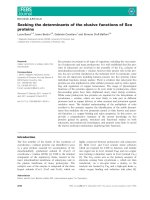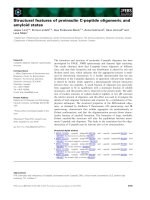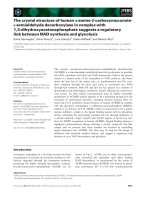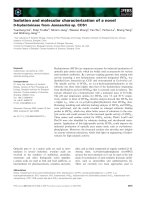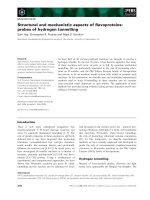Tài liệu Báo cáo khoa học: "SIMULATING CHILDREN''''S NULL SUBJECTS: A NEARLY LANGUAGE GENERATION MODEL" ppt
Bạn đang xem bản rút gọn của tài liệu. Xem và tải ngay bản đầy đủ của tài liệu tại đây (315.42 KB, 3 trang )
SIMULATING CHILDREN'S NULL SUBJECTS:
AN EARLY LANGUAGE GENERATION MODEL
Carole T.
Boster
Department of Linguistics, Box U-145
University of Connecticut
Storrs, CT 06269-1145, USA
Abstract
This paper reports work in progress on a sentence
generation model which attempts to emulate certain
language output patterns of children between the
ages of one and one-half and three years. In
particular, the model addresses the issue of why
missing or phonetically "null" subjects appear as
often as they do in the speech of young English-
speaking children. It will also be used to examine
why other patterns of output appear in the speech of
children learning languages such as Italian and
Chinese. Initial findings are that an output
generator successfully approximates the null-subject
output patterns found in English-speaking children
by using a 'processing overload' metric alone;
however, reference to several parameters related to
discourse orientation and agreement morphology is
necessary in order to account for the differing
patterns of null arguments appearing cross-
linguistically. Based on these findings, it is argued
that the 'null-subject phenomenon" is due to the
combined effects of limited processing capacity and
early, accurate parameter setting.
1 ~ PROBLEM
It is well known among researchers in language
acquisition that young children just beginning to
speak English frequently omit subjects, in linguistic
contexts where subjects are considered mandatory in
the adult language. Other major structural
components such as verbs and direct objects are also
omitted occasionally; however, the frequency at
which children omit mandatory object NPs tends to
be much lower than the rate at which they omit
subjects. For example, P. Bloom's (1990) analysis of
early speech transcripts of Adam, Eve and Sarah
(Brown, 1973) from the CHILDES database
(MacWhinney and Snow, 1985), indicates that these
children omitted subjects from obligatory contexts
55% of the time on average, whereas obligatory
objects were dropped at rates averaging only 9%.
But by around age 2 1/2, or when the mean length
of utterance (MLU) exceeds approximately 2.0
morphemes, the percentage of null subjects drops off
to a level about equal to the level of null objects.
The reason for the so-called null-subject
phenomenon in early child English has been widely
debated in the literature. Different theories, though
they vary greatly in detail, generally fall into two
broad categories: processing accounts and
parameter-setting accounts. The general claim of
those who favor a processing account is that the
phenomenon (in English) is caused by severe
limitations in the child's sentence-processing or
memory capacity. It is known that young children's
utterances are much shorter on average than
adults', that their sentence length increases steadily
with age, and that other components of a sentence
are also routinely omitted, which could be evidence
of processing limitations. Yet some who argue for a
strictly grammatical explanation (including Hyams
(1986), Hyams and Wex]er (1993)) claim that the
differential patterns of null subjects over null objects
cannot be accounted for by any existing processing
account, and instead take this as evidence that the
'unmarked' setting for the relevant parameter(s)
related to null subjects is (+pro-drop); various
accounts are offered for how children learning
languages that do not permit null subjects
ultimately make the switch to the correct parameter
Value.
Others, including Valian (1991) and Rizzi (1994)
have noted differences in the frequency of early null
subjects depending on their position in a sentence;
they tend to be omitted in matrix but not embedded
clauses, and in sentence-initial position but not after
a moved wh-element. This observation has been
used to argue for a different grammatical
explanation of the null-subject stage. Both
Lillo-Martin (1991) and Rizzi (1994), for example,
argue that the initial value of the parameters is set
to (- pro-drop); Lillo-Martin claims that the matrix
subject is outside the domain where the pro-drop
parameters are applied initially, while Rizzi claims
that the matrix CP is considered optional at an early
stage in acquisition. Further evidence which may
support either this approach or a 'combined'
processing and parameters account includes the
higher percentages and different patterns of pro-
drop and topic-drop found in the speech of children
learning Italian, a pro-drop language (Valian, 1991)
and Chinese, which allows 'topic-drop' (Wang et. al.,
322
1992), as compared to English-speaking children of
the same age and MLU. Processing constraints
should remain the same for children around the
globe, so it is not clear that processing alone can
account for the different distributions of nulls
exhibited by 2-year olds learning English, Italian,
and Chinese. However, the crosslinguistic
differences also argue against the claim that all
children start out with the relevant parameter(s)
initially set to (+pro-drop).
2 THE MODEL
FELICITY, a sentence generation model that
emulates early child language output, has been
designed in order to determine whether the 'null-
subject' phenomenon in early child language can
best be accounted for by an incorrect initial setting
of certain parameters, by processing limitations, or
by an interaction between parameter setting and
processing. FELICITY assumes a modular
approach, following Garrett (1975), in which the
intended message goes through three processing
modules to yield three levels of output: semantic,
then syntactic, then phonetic. The model
incorporates several standard assumptions of
Principles-and-Parameters theory including X'
structure-building capacity (Chomsky, 1981), head-
complement ordering parameters, and several
parameters currently thought to be relevant to the
null-subject phenomenon. Following the Continuity
Hypothesis (Pinker, 1984), the model has the
potential capacity for producing a full clausal
structure from the beginning; the structure-building
mechanism is presumed to be innate. It is also
assumed, following the VP-internal Subject
Hypothesis (Koopman and Spertiche (1988) and
others) that the subject is initially generated within
the VP. An algorithm controlling processing
capacity, similar in principle to that proposed by
Gibson (1991) to account for processing overload
effects in adult sentence processing, will limit
structure-building and dictate maximum "holding'
capacity before a sentence is output. The lexicon
will initially include all words used productively in
transcripts of an English-speaking child at age 1;7;
lexical entries will include information about
category, pronunciation, obligatory and optional
complements, and selectional restrictions on those
complements. All parameters will be binary. They
can be assigned either value initially and can be
reset; reference to any given parameter can also be
switched on or off. The processing capacity of the
model can also be adjusted, and the lexicon can be
updated.
The model will be able to produce a sentence
with a specific meaning or intent (as children
presumably do), if it is given certain data about the
intended proposition; this data will comprise a
semantic representation containing a verb, its theta-
grid (i.e. agent, experiencer, goal and/or theme),
information about time frame or tense, person and
number, mood, negation, and whether or not
arguments have been identified previously in the
discourse. When making direct comparisons of the
model's performance with children's actual
utterances, the data that is input to the model will
be coded on the basis of inferences about what the
child 'intended' to say based not only on actual
transcribed output but also from the situation, prior
discourse, and possibly caregiver's report (cf. L.
Bloom (1970) on 'rich interpretation' of children's
utterances).
Syntactic processing proceeds as follows: Begin
structure-building at the level of the matrix CP, but
via a recursive phrase-building process. Phrase-
building begins by merging a complement phrase
with its X ° head (after the complement phrase has
been built) to form an intermediate or X' level of
structure. This unit is then combined with its
specifier to form a 'maximal' phrase or XP. Lexical
items are inserted as soon as the appropriate X °
heads (or XPs, for pro-forms) become available.
Each time a structural unit is built, and each time
a lexical entry is inserted, the processing load is
incremented; when the maximum load is exceeded,
the model abandons processing and outputs the
words currently in the buffer.
$ INITIAL APPLICATION
FELICITY's output will be compared to actual
output from a longitudinal sample of several
English-speaking children's early utterances, using
transcripts available on the CHILDES database.
The initial lexicon will be constructed based on the
productive vocabulary of a given child from her first
transcript. The 'processing limit' will be set at a
given maximum, such that the model's MLU
approximates that of the child in the transcript; the
algorithm will be fine-tuned to determine how much
relative weight or processing 'cost' should be
assigned to (a) lexical lookup to get
subcategorization information for the verb; (b)
building of a structural unit; and (c) retrieval of
phonological information. The sentence-generation
procedures will be run under two conditions, once
with parameter-checking enabled and then with
parameter-checking disabled. Additional runs will
try to emulate the child's output patterns during
subsequent transcripts, after augmenting the
model's lexicon with new words found in the child's
vocabulary and adjusting the processing limit
upward so that the output matches the child's new
MLU. Statistical comparisons will be made between
the model's and the children's performance (at
323
comparable MLU levels) including percentages of
null subjects and null objects in the output,
percentages of overt nominalsubjects (full NPs) vs.
overt pronominal subjects, percentages of other
sentence components omitted, and amount of
variability in utterance lengths.
4 PRELIMINARY FINDINGS
Initial trials indicate that, once the processing-
complexity algorithm is tuned appropriately,
FELICITY can approximate the null~subject output
patterns found in English-speaking children with no
reference to parameter values. Indeed, because the
model builds complements before specifiers, it
produces a much higher incidence of null subjects
than null objects using a proceseing-overload metric
alone. Furthermore, it yields a higher incidence of
nulls in matrix sentences than in embedded clauses,
and within a clause it only omits subjects in initial
position, not after a moved wh-element or topic.
However, it appears that the model will also need to
reference parameter values if it is to account for the
patterns observed in the speech of children learning
languages which d_oo allow null arguments;
processing constraints alone will not explain the
different croselin~mistic distributions of nulls.
5 FUTURE APPLICATIONS
Once FELICITY's processing metric is fine-tuned for
English, it can be used to emulate argument
omission patterns shown in other languages like
Italian and Chinese, to test various parametric
theories. If the relevant parameters involved are as
given in Lillo-Martin (1991), for example, FELICITY
should be able to emulate the relatively high level of
null-subject usage by Italian-speaking children
reported in Valian (1991) by simply switching
certain subparameters related to Null Pronoun
Licensing (NPL) and Null Pronoun Identification
(NTI) to positive for an Italian child at age 2, while
keeping processing constraints at the same levels
that were established for English-speaking children.
The model should also be able to emulate the higher
percentages of null subjects and null objects found in
the output of Chinese-speaking children in
experiments reported in Wang et. al. (1992) by
simply switching the Discourse Oriented (DO)
parameter to positive, while leaving the NPL and
NPI parameters set at the default (negative) values.
FELICITY can also be used to address theories
pertaining to other aspects of language acquisition
that appear slightly later in development, such as
the appearance of subject-auxiliary inversion in
yes/no and wh-questions, and the emergence of
Tense and Agreement features. Future
enhancements to the model are planned with these
applications in mind.
ACKNOWLEDGMENTS
This material is based upon work supported under
a National Science Foundation Graduate Research
Fellowship. Thanks go to my committee members
Diane Lillo-Martin, Stephen Crain, Ted Gibson and
Howard Lasnik, and to two anonymous reviewers for
helpful comments on an earlier draft.
REFERENCES
Bloom, L. (1970). Language development: Form and
function in emerging grammars. Cambridge,
Mass.: MIT Press,
Bloom, P. (1990). Subjectless sentences in child
language. Linguistic Inauiry, ~ 491-504.
Brown, R. (1973). Afirst language: The early stages.
Cambridge, Mass.: Harvard University Press.
Chomsky, N. (1981). Lectures on government and
binding. Dordrecht: Foris.
Garrett, M. F. (1975). The analysis of sentence
production. In G. Bower (Ed.), P .sychology of
learning and motivation (Vol. 9). New York:
Academic Press.
Gibson, E. A. F. (1991). A computational theory of
human linguistic processing: Memory
limitations and processing breakdown [Doctoral
dissertation]. Pittsburgh: Carnegie Mellon
University.
Hyams, N. M. (1986). Language acquisition and the
theory of parameters. Dordrecht: D. Reidel
Publishing Company.
Hyams, N., & Wex]er, K. (1993). On the
grammatical basis of null subjects in child
language. Linguistic InQuiry, 24, 421-459.
Koopman, H., & Sportiche, D. (1988). Subjects [Ms.].
Los Angeles: UCLA.
Lillo-Martin, D. C. (1991). Universal Grammar and
American Sign Language: Setting the Null
Argument Parameters. Dordrecht: Kluwer
Academic Publishers.
MacWhinney, B., & Snow, C. (1985). The Child
Language Data Exchange System. Journal of
Child Language, 12, 271-296.
Pinker, S. (1984). Language learnability and
language development. Cambridge, Mass.:
Harvard University Press.
Rizzi, L. (1994). Early null subjects and root null
subjects. In T. Hoekstra & B. D. Schwartz
• (Eds.), Language acquisition studies in
generative grammar (pp. 151-176).
Amsterdam/Philadelphia: John Benjamins.
Valian, V. (1991). Syntactic subjects in the early
speech of American and Italian children.
Cognition, ~ 21-81.
Wang, Q., Lillo-Martin, D., Best, C. T., & Levitt, A.
(1992). Null subject versus null object: Some
evidence from the acquisition of Chinese and
English. Language Acquisition, ~ 221-254.
324

